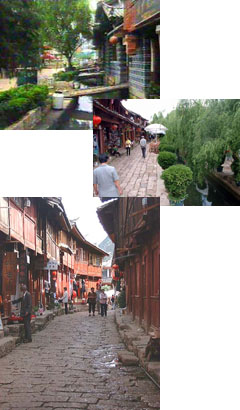 |
|
| The Old Street in Lijiang |
| CCTV.COM 2003-06-24 22:06:07 |
|
 The bridges, rivers and houses probably make you think you have come to the southern part of the lower reaches of the Yangtze River. In fact, however, it is on the plateau of 2,400 meters high. The small town like the water region in the southern part of the lower reaches of the Yangtze River is the ancient town of Lijiang in Yunnan Province. The bridges, rivers and houses probably make you think you have come to the southern part of the lower reaches of the Yangtze River. In fact, however, it is on the plateau of 2,400 meters high. The small town like the water region in the southern part of the lower reaches of the Yangtze River is the ancient town of Lijiang in Yunnan Province.
At the center of the ancient town of Lijiang is the Square Street. It’s said to be shaped as a seal of a prefect, symbolizing an omnipresent power. In fact, the street is a marketing square developed from an open-air fair in the countryside. In the past, the bronze wares, Tibetan knives and Yunnan tea carried here by trains of horses from the ancient tea-and-horse road and Yunnan tea were exchanged with other things in this place or transferred from here to the other places.
For thousands of years, trains of horses from north and south had experienced arduous journeys along the lofty ridges and towering mountains in southwest China. So a famous tea-and-horse road in the Chinese history was formed under the horses’ hoofs.
The ancient town of Lijiang is surrounded with mountains. So it is hard to get to. However, as recorded in the historical archives, it had been a thriving trading place as early as in the Yuan Dynasty.
On the spotted-stone street are the tracks over thousands of years. There would be no the thriving scene in the history of the ancient street without the trains of horses coming and going.
The ancient street stretches out with the Square Street as its center. Starting from the Song Dynasty, the Naxi people had begun to build their settlement in here. They had built streets and houses along the natural course of the river.
“The arrangement of the ancient streets in Lijiang is different from that of Beijing. It’s not in a regular and square shape. It’s based on the natural conditions. The streets make a good use of the rivers and topography. The arrangement’s effective. The main streets are connected to the river. So every household can enjoy enough water. Thus, a harmonious relationship has been formed between nature and human beings,” said Xie Ninggao, professor of Urban Environment Department of Peking University.
In the ancient town of Lijiang there is a “street-washing” activity every once in a while. The so-called “street-washing” is to open the water gate to the Western River of the Square Street. Then the river water makes use of the physical momentum and flows along the streets so that every household can clean the street with brooms.
The Ancient Street of Lijiang also enjoys a reputation of not dusty in drought and nor muddy on a rainy day.
Walking along the Ancient Street of Lijiang, you will never lose your way if only you can find the Jade-dragon Snow Mountain in the north. Although bordered to the snow mountain, the inner climate of the town is as warm as spring. And the arrangement of the spotted-stone bricks should not be ignored, it plays a role of road mark.
“If you see three stone-paved roads before you, just go ahead according to your direction. You’ll never reach a dead end and backtrack. The road represents a culture of road mark,” said Li Afan, vice-director of Lijiang Bureau of Town Construction.
Today, people in this place not only can enjoy the antique style of the architectures in the Ming and Qing Dynasties but also can sense the cultural spirit of multiple nationalities such as Han, Tibet and Naxi. The ordinary streets have reflected the wisdom of the Naxi people and their pursuit of a happy life.
In 1997, the ancient town of Lijiang was included in the list of the world cultural heritage approved by the United Nations Educational, Scientific and Cultural Organization, which makes it a common wealth of the entire mankind.
|
|
Editor: Liu Baoyin CCTV.com
|
|
|
|
|
|
 |









